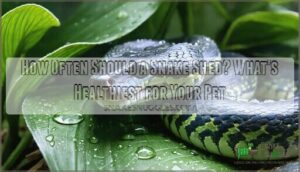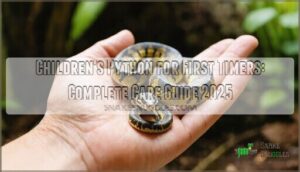This site is supported by our readers. We may earn a commission, at no cost to you, if you purchase through links.
 Your snake should shed its skin every 4-12 weeks for healthy development, though this varies by age and species.
Your snake should shed its skin every 4-12 weeks for healthy development, though this varies by age and species.
Young snakes grow faster and shed more frequently than adults, sometimes monthly. Ball pythons typically shed every 6-8 weeks, while corn snakes might shed every 4-6 weeks.
You’ll know shedding time’s approaching when your snake’s eyes turn milky blue and its skin looks dull. Proper humidity levels around 50-60% help promote clean, complete sheds.
If you’re wondering how often should a snake shed what’s healthiest, consistency matters more than exact timing. Watch for stuck shed pieces, cloudy patches, or irregular shedding patterns that signal potential problems, which can be affected by proper humidity and complete sheds.
Table Of Contents
- Key Takeaways
- Why Do Snakes Shed Their Skin?
- How Often Should a Healthy Snake Shed?
- Signs Your Snake is About to Shed
- What’s The Shedding Process?
- Preventing Shedding Problems
- Signs of an Unhealthy Shed
- Ensuring Proper Husbandry
- Frequently Asked Questions (FAQs)
- How often do snakes shed their skin?
- Do snakes shed more than adults?
- How do you care for a snake during its shedding cycle?
- How long does a snake shedding last?
- Should you remove skin from a snake after shedding?
- Why would a snake shed twice a month?
- How often should a healthy snake shed?
- How often do snakes shed skin averagely?
- How can I help my snake shed better?
- How often do snakes go into the shed?
- Conclusion
Key Takeaways
- Monitor your snake’s age-based shedding patterns – Young snakes shed every 2-4 weeks due to rapid growth, while adults shed 3-6 times yearly, so you’ll know what’s normal for your pet’s life stage.
- Watch for pre-shed warning signs – You’ll notice cloudy or milky blue eyes, dull skin color, increased hiding behavior, and appetite loss 1-2 weeks before your snake actually sheds.
- Maintain proper humidity levels of 50-60% – This prevents stuck shed and ensures your snake can remove its old skin in one complete piece rather than in problematic patches.
- Don’t interfere with the natural shedding process – You should never manually pull at loose skin or handle your snake during shedding, as this can cause injuries and complications that require veterinary care.
Why Do Snakes Shed Their Skin?
Unlike your old winter coat that you outgrow, your snake’s skin doesn’t stretch. The outer layer consists of rigid keratin layers that can’t expand with your pet’s growing body.
Your snake’s skin is like armor that never grows – when it gets too tight, it’s time for a complete wardrobe change.
This creates a fascinating biological puzzle that nature solves through the reptile shedding process. Snake shedding, also called ecdysis, allows your snake to replace worn-out skin with fresh, healthy tissue.
The snake skin shedding process serves multiple purposes beyond just accommodating skin growth. It removes parasites, repairs minor injuries, and maintains proper hydration levels.
During the snake shedding process, new skin develops underneath the old layer. When ready, your snake will rub against rough surfaces to start peeling away the complete shed in one piece.
This nutrient replacement process guarantees your pet maintains healthy, functional skin throughout its life. Think of it as nature’s way of giving your snake a fresh start every few months.
How Often Should a Healthy Snake Shed?
A healthy snake typically sheds its skin three to six times per year, though this frequency depends on the snake’s age and species.
You’ll notice that younger snakes shed more often than adults because they’re growing rapidly, while mature snakes require fewer sheds to maintain their skin health.
Age Differences
Your snake’s age dramatically affects how often they’ll shed their skin.
Juvenile shedding happens much more frequently than you might expect – young snakes can shed every 2-4 weeks as their bodies grow rapidly.
Adult frequency drops substantially, with mature snakes shedding just 3-6 times yearly.
Senior sheds become even less common, sometimes occurring only once or twice per year.
Growth rate directly impacts shed intervals, creating predictable patterns:
- Baby snakes outgrow their skin like kids outgrowing clothes
- Teenage snakes slow down but still shed monthly
- Adult snakes settle into comfortable seasonal rhythms
- Senior snakes take their sweet time between sheds
- Each life stage brings different shedding expectations
Understanding these age differences helps you monitor your pet’s health effectively.
This knowledge is key to recognizing normal shedding patterns and identifying any potential issues early on, which is crucial for maintaining your snake’s overall well-being.
Species Differences
Your pet’s species plays a major role in determining healthy snake shedding frequency.
Desert species like sand boas typically shed 2-4 times yearly due to their dry habitat impact, while aquatic species require more frequent shedding—often 6-8 times annually—because constant moisture affects their skin.
Tropical snakes generally shed more than temperate varieties, with shedding variation reaching 4-12 times per year.
Captive vs wild environments also influence these patterns, as controlled humidity and temperature in captivity can increase snake shedding frequency compared to unpredictable natural conditions, which is impacted by the desert species and their adaptation to dry habitat.
Signs Your Snake is About to Shed
Recognizing snake shedding signs helps you provide better care during this vulnerable time.
Your snake’s behavior and appearance will change noticeably before the actual shed begins.
Your snake transforms before your eyes, sending clear signals that a fresh skin reveal is coming soon.
Watch for these telltale snake shedding signs:
- Cloudy eyes or milky eyes – Eyes turn blue-white as fluid builds between skin layers
- Dull skin – Colors fade and scales lose their usual shine
- Behavior changes – Increased hiding behavior and defensive responses like hissing
- Appetite loss – Complete refusal to eat for days or weeks
Scale loosening follows these initial signs.
What’s The Shedding Process?
Once you’ve spotted the warning signs, your snake enters a predictable snake shedding cycle with distinct snake shedding stages.
The shedding process begins when new skin forms underneath the old layer, creating skin separation. Your snake’s eyes will turn milky or cloudy during what’s called the blue phase – this happens because fluid builds up between the old and new eye caps.
During this time, you’ll notice increased rubbing behavior as your snake uses rough surfaces to loosen the old skin. The entire process takes one to two weeks from start to finish.
When ready, your snake will work methodically to remove the old skin, ideally achieving a complete shed in one piece. The skin comes off inside-out, like peeling off a sock. Younger snakes move through these stages faster than adults due to their rapid growth rates.
Preventing Shedding Problems
Your snake’s shedding success depends heavily on the environment you create. Think of it like preparing the perfect stage for a natural performance – everything needs to be just right.
Humidity Control stands as your first line of defense against snake shedding problems. Most species need 50-70% humidity during shed cycles, so invest in a reliable hygrometer and adjust accordingly. Diet Impact can’t be overlooked either – well-nourished snakes shed more easily than undernourished ones. Stick to species-appropriate feeding schedules and prey sizes.
Substrate Choice matters more than you’d think. Rough surfaces like bark or rocks give your snake something to rub against, helping the old skin come off naturally. A reptile fogger can help maintain ideal humidity levels during shedding.
Here are three essential steps for preventing shedding problems:
- Monitor humidity levels daily and maintain ideal shedding conditions
- Provide appropriate rough surfaces for natural skin removal
- Avoid disturbing your snake during the shed cycle
Smart Handling Practices mean leaving your snake alone during shedding. Resist the urge to help – your intervention often causes more harm than good.
Signs of an Unhealthy Shed
You’ll know your snake’s having shedding problems when the skin comes off in pieces instead of one complete piece, or when patches of old skin remain stuck to the body.
These issues, called dysecdysis and retained shed, can lead to infections and circulation problems if you don’t address them quickly.
Dysecdysis
Dysecdysis occurs when your snake can’t shed properly, leaving patches of old skin stuck to their body.
This abnormal shedding indicates underlying problems that need attention.
| Causes of Dysecdysis | Identifying Dysecdysis |
|---|---|
| Low humidity levels | Stuck skin patches |
| Improper temperatures | Dull, cloudy eyes |
| Poor nutrition | Layered skin buildup |
| Dehydration | Pinched toes/tail |
| Parasites or infections | Decreased activity |
Treating dysecdysis requires addressing root causes—adjusting humidity, temperature, and diet.
Environmental factors, such as inadequate humidity levels, are often primary contributors to this condition.
Preventing dysecdysis through proper husbandry beats dealing with shedding complications later.
Retained Shed
Looking beyond normal shedding patterns, retained shed occurs when old skin sticks to your snake’s body in patches or strips.
This incomplete snake shed creates serious complications if ignored.
Here’s what signals snake shedding difficulties:
- Dull, wrinkled skin patches clinging to your snake’s body
- Cloudy or stuck eye caps that didn’t come off properly
- Tight bands around the tail that can cut off circulation
- Skin buildup in body creases or around scales
- Multiple failed attempts at stuck shed removal
Prevention requires proper humidity and prompt treatment prevents dangerous infections.
You can also use snake shed products to assist the process.
Ensuring Proper Husbandry
When shedding problems arise, proper husbandry becomes your first line of defense. Your snake’s environment directly impacts snake shedding frequency and success.
Essential Husbandry Elements for Healthy Shedding
| Husbandry Factor | Requirement | Impact on Shedding |
|---|---|---|
| Ideal Humidity | 50-60% for most species | Prevents stuck shed, enables clean removal |
| Temperature Gradients | Basking spot + cool side | Promotes circulation, aids skin separation |
| Balanced Diet | Species-appropriate nutrition | Supports healthy skin regeneration |
| Suitable Substrates | Appropriate texture/moisture | Provides rubbing surfaces for shed removal |
| Hiding Spots | Multiple secure areas | Reduces stress during vulnerable shedding period |
Monitor these elements consistently using reliable equipment. Maintaining proper humidity levels requires a reliable humidity reader.
Poor snake husbandry directly correlates with problematic sheds. Your snake care routine should prioritize shedding environment setup that supports natural behaviors. When you maintain proper conditions, you’ll notice improved snake shedding frequency and cleaner, complete sheds that indicate optimal health.
Frequently Asked Questions (FAQs)
How often do snakes shed their skin?
Like clockwork, your snake’s skin renewal follows a predictable pattern.
Young snakes shed every 2-4 weeks due to rapid growth, while adults shed 3-6 times yearly, with frequency decreasing as they mature.
Do snakes shed more than adults?
Yes, young snakes shed substantially more than adults. Juveniles shed every 2-4 weeks due to rapid growth, while adults typically shed just 3-6 times yearly as their growth slows.
How do you care for a snake during its shedding cycle?
Ever wondered how to help your snake through its vulnerable shedding phase?
Maintain proper humidity levels, avoid handling during the process, provide rough surfaces for rubbing, and never pull at loose skin manually.
How long does a snake shedding last?
The entire shedding process typically takes one to two weeks from start to finish.
You’ll notice cloudy eyes and dull skin first, then your snake will actively shed within minutes to hours once ready.
Should you remove skin from a snake after shedding?
Never manually remove your snake’s shed skin, even if it looks loose or ready.
Let nature handle the process—pulling at shed skin can injure your snake and cause serious complications that require veterinary treatment.
Why would a snake shed twice a month?
Notably, rapid growth spurts cause young snakes to shed twice monthly.
You’re witnessing normal development as their skin can’t stretch with their expanding bodies.
This frequent shedding typically occurs in snakes under six months old, and is a result of their rapid growth, which can be considered normal development.
How often should a healthy snake shed?
Healthy snakes shed 4-12 times yearly, with young snakes shedding every 2-4 weeks and adults every 1-3 months.
You’ll know it’s normal when sheds come off completely in one piece without complications, which indicates a complete shed.
How often do snakes shed skin averagely?
Snakes typically shed their skin 4-12 times per year, depending on their age and species.
You’ll notice younger snakes shed more frequently than adults since they’re growing rapidly and need room to expand.
How can I help my snake shed better?
Like providing a spa day for your pet, you’ll want to boost humidity levels, maintain proper temperatures, and offer rough surfaces for rubbing.
Don’t pull stuck skin—let your snake handle the process naturally.
How often do snakes go into the shed?
Your snake typically enters the shedding process every 4-8 weeks, depending on its age and species.
Younger snakes shed more frequently than adults.
You’ll notice cloudy eyes and dull skin signaling the start.
Conclusion
Like a well-oiled clock, your snake’s shedding schedule reveals its overall health status. Understanding how often should a snake shed what’s healthiest empowers you to provide ideal care for your scaly companion.
Young snakes shed monthly, while adults follow 6-12 week cycles depending on species.
Monitor humidity levels, watch for pre-shed signs, and address stuck shed immediately. Consistent shedding patterns indicate proper husbandry, while irregular cycles suggest environmental adjustments are needed for your pet’s wellbeing.










